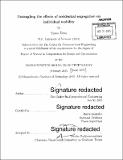| dc.contributor.advisor | Marta González. | en_US |
| dc.contributor.author | Desu, Suma | en_US |
| dc.contributor.other | Massachusetts Institute of Technology. Computation for Design and Optimization Program. | en_US |
| dc.coverage.spatial | n-us-ma | en_US |
| dc.date.accessioned | 2017-02-16T16:43:47Z | |
| dc.date.available | 2017-02-16T16:43:47Z | |
| dc.date.copyright | 2015 | en_US |
| dc.date.issued | 2015 | en_US |
| dc.identifier.uri | http://hdl.handle.net/1721.1/106957 | |
| dc.description | Thesis: S.M., Massachusetts Institute of Technology, School of Engineering, Center for Computational Engineering, Computation for Design and Optimization Program, 2015. | en_US |
| dc.description | Title as it appears in MIT Commencement Exercises program, June 5, 2015: Quantifying the effects of residential segregation on individual mobility Cataloged from PDF version of thesis. | en_US |
| dc.description | Includes bibliographical references (pages 60-64). | en_US |
| dc.description.abstract | More than half of today's world population lives in cities and that fraction is steadily growing. Models that accurately capture all segments of the population are necessary in order to design effective policies and new technologies to ensure efficient and stable operations of cities. The current sociology literature has a rich foundation in characterizing the demographics of static population distributions, however, these characterizations fail to account for the reality of dynamic movement. Though there has been recent work in developing models of human mobility, they in turn do not capture demographic differences in the populations of cities. In this work we present a computational approach to reformulating segregation metrics to incorporate dynamic movement patterns and also quantify the effects of introducing demographics into a mobility model. In coupling two fields that are inherently connected but not established as so, we must very carefully consider our experimental set up. The first part of this work deals with understanding our data and its limitations at fine granularities and explicitly measuring segregation metrics at various scales to design a study that will elucidate meaningful aspects of segregation. In the second part of this work we reformulate traditional segregation metrics using topological properties of origin destination networks as input. These measures are flexible in considering many locations that individuals visit and therefore more accurately capture the environments of individuals that traditional segregation literature seeks to characterize. We utilize two rank-based mobility models that implicitly incorporate geographic properties of population distributions to understand the effects of residential segregation on mobility patterns and examine the effect of demographic considerations on model accuracy. In summary, this thesis will focus on synthesizing the rich body of work on static characterizations of socioeconomic structure in cities with dynamic models to better understand different racial segmentations of Boston's population. This work is both an extension to static segregation literature as well as a refinement of current mobility models. | en_US |
| dc.description.statementofresponsibility | by Suma Desu. | en_US |
| dc.format.extent | 64 pages | en_US |
| dc.language.iso | eng | en_US |
| dc.publisher | Massachusetts Institute of Technology | en_US |
| dc.rights | MIT theses are protected by copyright. They may be viewed, downloaded, or printed from this source but further reproduction or distribution in any format is prohibited without written permission. | en_US |
| dc.rights.uri | http://dspace.mit.edu/handle/1721.1/7582 | en_US |
| dc.subject | Computation for Design and Optimization Program. | en_US |
| dc.title | Untangling the effects of residential segregation on individual mobility | en_US |
| dc.title.alternative | Quantifying the effects of residential segregation on individual mobility | en_US |
| dc.type | Thesis | en_US |
| dc.description.degree | S.M. | en_US |
| dc.contributor.department | Massachusetts Institute of Technology. Computation for Design and Optimization Program | |
| dc.identifier.oclc | 936557678 | en_US |
